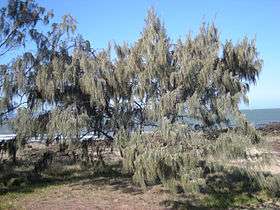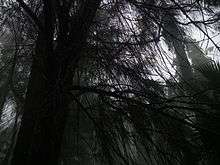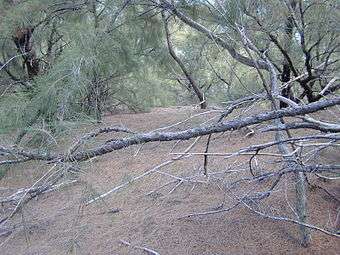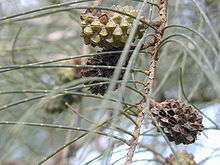Casuarina equisetifolia
Casuarina equisetifolia, the Australian pine tree or whistling pine tree, is a she-oak species of the genus Casuarina. The native range extends throughout Southeast Asia, Northern Australia and the Pacific Islands; including Thailand, Myanmar, Vietnam, Malaysia, Brunei, Indonesia, Timor-Leste, and the Philippines (where it is known as agoho pine),[1] east to Papua New Guinea, French Polynesia, New Caledonia, and Vanuatu, and south to Australia (north of Northern Territory, north and east Queensland, and north-eastern New South Wales).[2] Populations are also found in Madagascar, but it is doubtful if this is within the native range of the species.[3][4] The species has been introduced to the Southern United States and West Africa.[5] It is an invasive species in Florida,[6][7] South Africa, India and Brazil.[8]
| Casuarina equisetifolia | |
|---|---|
 | |
| C. equisetifolia subsp. incana | |
| Scientific classification | |
| Kingdom: | Plantae |
| Clade: | Tracheophytes |
| Clade: | Angiosperms |
| Clade: | Eudicots |
| Clade: | Rosids |
| Order: | Fagales |
| Family: | Casuarinaceae |
| Genus: | Casuarina |
| Species: | C. equisetifolia |
| Binomial name | |
| Casuarina equisetifolia | |
| Subspecies | |
| |
.jpg)


Taxonomy
Casuarina equisetifolia was officially described by Linnaeus in 1759 as Casuarina equisefolia. A type was designated by New South Wales botanist Lawrie Johnson in 1989.[9] The specific name equisetifolia is derived from the Latin equisetum, meaning "horse hair" (referring to the resemblance of the drooping branchlets to horse tail).[2] Common names include coast sheoak (coast she oak, coastal she-oak), beach casuarina, beach oak, beach sheoak (beach she-oak), beach pine, whistling tree, horsetail she oak, horsetail beefwood, horsetail tree, Australian pine, ironwood, whistling pine, Filao tree, and agoho.[2][9][10]
There are two subspecies:[11][12]
- Casuarina equisetifolia subsp. equisetifolia. Large tree to 35 m (115 ft) tall; twigs 0.5–0.7 mm (0.020–0.028 in) diameter, hairless. Southeast Asia, northern Australia.[13]
- Casuarina equisetifolia subsp. incana (Benth.) L.A.S.Johnson. Small tree to 12 m (39 ft) tall; twigs 0.7–1 mm (0.028–0.039 in) diameter, downy. Eastern Australia (eastern Queensland, New South Wales), New Caledonia, southern Vanuatu.[14]

Description
Casuarina is an evergreen tree growing to 6–35 m (20–115 ft) tall. The foliage consists of slender, much-branched green to grey-green twigs 0.5–1 mm (0.020–0.039 in) diameter, bearing minute scale-leaves in whorls of 6–8. The flowers are produced in small catkin-like inflorescences; the male flowers in simple spikes 0.7–4 cm (0.28–1.57 in) long, the female flowers on short peduncles. Unlike most other species of Casuarina (which are dioecious) it is monoecious, with male and female flowers produced on the same tree. The fruit is an oval woody structure 10–24 mm (0.39–0.94 in) long and 9–13 mm (0.35–0.51 in) in diameter, superficially resembling a conifer cone made up of numerous carpels each containing a single seed with a small wing 6–8 mm (0.24–0.31 in) long.[3][15]
Like some other species of the genus Casuarina, C. equisetifolia is an actinorhizal plant able to fix atmospheric nitrogen. In contrast to species of the plant family Fabaceae (e.g., beans, alfalfa, Acacia), Casuarina harbours a symbiosis with a Frankia actinomycete.
Distribution and habitat
Casuarina is found from Myanmar and Vietnam throughout Malesia east to French Polynesia, New Caledonia, and Vanuatu, and south into Australia (the northern parts of Northern Territory, north and east Queensland, and northeastern New South Wales, where it extends as far south as Laurieton.[16]
Uses
Casuarina is widely used as a bonsai subject, particularly in South-east Asia and parts of the Caribbean. Indonesian specimens and those cultivated in Taiwan are regarded among the best in the bonsai world. The wood of this tree is used for shingles, fencing, and is said to make excellent hot-burning firewood. Among the islands of Hawaii, Casuarina are also grown for erosion prevention, and in general as wind breaking elements.
The legendary miraculous spear Kaumaile came with the hero Tefolaha on the South Pacific island Nanumea. He fought with it on the islands of Samoa and Tonga. As Tefolaha died, "Kaumaile" went to his heirs, then to their heirs, and on and on - 23 generations. It is about 1.80 meters long and about 880 years old and the tree was cut on Samoa.[17]
The Casuarina leaves are usually used for ornamental purposes in the urban region.
Other than ornamental purposes, the Casuarina was also explored in for its potential in remediation of textile dye wastewater. Casuarina leaves were found to be useful as absorbent material for the removal of textile dyes such as reactive orange 16[18] Rhodamine B,[19] methylene blue, malachite green[20] and methyl violet 2b.[21] Similarly the Casuarina dried cone was also reported to be able to remove Rhodamine B,[22] and methyl violet 2b.[23] The Casuarina bark was reported to able to remove methylene blue.[24] Even the Casuarina seed was also found to be useful in dye removal of neutral red and malachite green.[25] The carbon derived from the cones of Casuarina was found to be good absorbent for the landfill leachate,[26] while another laboratory also reported good absorbent for copper ions from aqueous solution.[27] Casuarina equisetifolia Lin. (Casuarinaceae) has been used traditionally for treating inflammation, cancer and other diseases, but its efficacy has not been scientifically examined in treating arthritis; the bark extract showed anti-arthritic activity.[28] Methanolic extract of Casuarina equisetifolia fruit contain significant percentage of secondary metabolite like poly phenol, it showed antioxidant and anti-arthritic activity.[29] Methanolic extract of Casuarina equisetifolia Lin. Leaf against Ehrlich Ascites Carcinoma Induced Cancer in Mice; possess protective action on the hemopoietic system.[30]
Gallery
 C. equisetifolia subsp. equisetifolia
C. equisetifolia subsp. equisetifolia C. equisetifolia stems and leaves
C. equisetifolia stems and leaves C. equisetifolia fruits
C. equisetifolia fruits C. equisetifolia seed
C. equisetifolia seed
See also
- Pinus kesiya, the Khasi or Benguet pine
References
- "Agoho". The Trees of Alabang Hills, Muntinlupa, Philippines. Retrieved 12 March 2019.
- Boland, D. J.; Brooker, M. I. H.; Chippendale, G. M.; McDonald, M. W. (2006). Forest trees of Australia (5th ed.). Collingwood, Vic.: CSIRO Publishing. p. 82. ISBN 0-643-06969-0.
- "Casuarina equisetifolia L., Amoen. Acad. 143 (1759)". Australian Biological Resources Study. Australian National Botanic Gardens. Retrieved 23 April 2011.
- "Archived copy". Archived from the original on 2012-07-31. Retrieved 2011-10-12.CS1 maint: archived copy as title (link)
- "Plant for the Planet: Billion Tree Campaign" (PDF). United Nations Environment Programme. Retrieved 23 April 2011.
- "Biological control of Australian native Casuarina species in the USA". Commonwealth Scientific and Industrial Research Organisation. 16 May 2007. Archived from the original on 5 June 2011. Retrieved 16 September 2010.
- Masterson, J. "Casuarina equisetifolia (Australian Pine)". Fort Pierce: Smithsonian Marine Station. Retrieved 5 May 2009.
- "SANBI:Declared Weeds & Invader Plants". South African National Biodiversity Institute. Archived from the original on 2014-10-06. Retrieved 25 September 2014.
- "Casuarina equisetifolia L." Australian Plant Name Index (APNI), IBIS database. Centre for Plant Biodiversity Research, Australian Government.
- "Casuarina equisetifolia". World Agroforestry Centre. Archived from the original on 30 September 2011. Retrieved 23 April 2011.
- "Australian Plant Name Index (APNI)". Australian National Botanic Gardens. Retrieved 23 April 2011.
- "Casuarina equisetifolia". Germplasm Resources Information Network (GRIN). Agricultural Research Service (ARS), United States Department of Agriculture (USDA). Retrieved 23 April 2011.
- "Casuarina equisetifolia L. subsp. equisetifolia". Australian Biological Resources Study. Australian National Botanic Gardens. Archived from the original on 18 May 2008. Retrieved 23 April 2011.
- "Casuarina equisetifolia subsp. incana". Australian Biological Resources Study. Australian National Botanic Gardens. Archived from the original on 18 May 2008. Retrieved 23 April 2011.
- Huxley, Anthony; Griffiths, Mark; Levy, Margot (1992). The New Royal Horticultural Society dictionary of gardening. Volume 1. London: Macmillan. ISBN 0-333-47494-5.
- K. L. Wilson & L. A. S. Johnson. "New South Wales Flora Online: Casuarina equisetifolia". Royal Botanic Gardens & Domain Trust, Sydney, Australia.
- "S dsee-Speer: Hamburger Forscher bestimmt Holzart". Spiegel Online. 30 May 2014. Retrieved 25 September 2014.
- http://nopr.niscair.res.in/handle/123456789/42920%5B%5D%5B%5D
- Kooh, Muhammad Raziq Rahimi; Dahri, Muhammad Khairud; Lim, Linda B.L (2016). "The removal of rhodamine B dye from aqueous solution using Casuarina equisetifolia needles as absorbent". Cogent Environmental Science. 2. doi:10.1080/23311843.2016.1140553.
- Dahri, Muhammad Khairud; Kooh, Muhammad Raziq Rahimi; Lim, Linda B.L (2015). "Application of Casuarina equisetifolia needle for the removal of methylene blue and malachite green dyes from aqueous solution". Alexandria Engineering Journal. 54 (4): 1253. doi:10.1016/j.aej.2015.07.005.
- Dahri, Muhammad Khairud; Kooh, Muhammad Raziq Rahimi; Lim, Linda B. L (2013). "Removal of Methyl Violet 2B from Aqueous Solution Using Casuarina equisetifolia Needle". ISRN Environmental Chemistry. 2013: 1. doi:10.1155/2013/619819.
- Dahri, Muhammad Khairud; Kooh, Muhammad Raziq Rahimi; Lim, Linda B. L (2016). "Remediation of Rhodamine B Dye from Aqueous Solution Using Casuarina equisetifolia Cone Powder as a Low-Cost Absorbent". Advances in Physical Chemistry. 2016: 1. doi:10.1155/2016/9497378.
- http://www.vinanie.com/jebr/articles/v6n1p34.html%5B%5D%5B%5D
- http://en.cnki.com.cn/Article_en/CJFDTOTAL-ZKZX201006017.htm%5B%5D
- http://www.jfas.info/index.php/jfas/article/view/3342%5B%5D%5B%5D
- Alrozi, Rasyidah; Zubir, Nor Aida; Kamaruddin, Mohamad Anuar; Yusof, Siti Noor Faizah Mohd; Yusoff, Mohd Suffian (2017). "Removal of organic fractions from landfill leachate by Casuarina equisetifolia activated carbon: Characteristics and absorption mechanisms". AIP Conference Proceedings. AIP Conference Proceedings. 1885: 020139. Bibcode:2017AIPC.1885b0139A. doi:10.1063/1.5002333.
- http://jestec.taylors.edu.my/Vol%2012%20issue%202%20February%202017/12_2_1.pdf%5B%5D%5B%5D
- Appraisal of anti-arthritic potential of Casuarina equisetifolia Lin. bark extract. Dharmesh K. Golwala, Santoshkumar Vaidya, Asit Ranjan Sahu. Aegaeum Journal (ISSN: 0776-3808) 2020: Volume 8, Issue 2, page 229-240.
- Antioxidant and Anti-arthritic Potential of Casuarina equisetifolia Fruit Methanolic Extract. Santoshkumar Vaidya, Dharmesh K. Golwala, Mitali V. Shrimanker, Darpini S. Patel and Satyajit Sahoo. European Journal of Medicinal Plants (ISSN: 2231-0894) 2020: Volume 31, Issue 1, page: 42-53.
- Evaluation of anticancer potential of Casuarina equisetifolia lin. (Casuarinaceae) leaf methanolic extracts against Ehrlich ascites carcinoma induced cancer in mice. Santoshkumar Vaidya, Dharmesh K. Golwala, Urmi M. Vora and Darpini S. Patel. Aegaeum Journal (ISSN: 0776-3808) 2020: Volume 8, Issue 2, page 202-214.
External links
- NT Flora: Casuarina equisetifolia. Northern Territory Government.
| Wikimedia Commons has media related to Casuarina equisetifolia. |